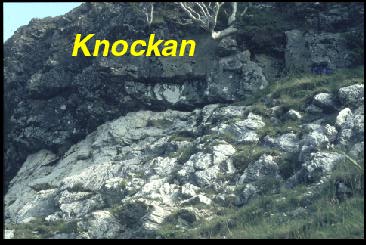Map of Knockan crag
View from a distance
KNOCKAN CRAG (NC186084 - 221092)
For much of its outcrop length from Loch Eriboll to Skye, the basal contact of the Moine Thrust Sheet is generally poorly exposed. A glorious exception to this is found at the Knockan area, a site that is doubly fortunate in being very easily accessible. Here mylonites derived from the Moine metasediments overlie carbonates of the Durness Group. The section at Knockan Crag is deceptive in that it displays an apparently simple upward progression through the foreland Cambro-Ordovician strata into the apparently conformable Moine. Indeed the entire thrust belt is here represented by the Moine Thrust alone. Within a few metres of the thrust, carbonates of the Durness Group are sheared and cut by cataclastic seams and veins although deformation structures are absent below. In contrast, the overlying Moine is dominated by crystal-plastic deformation mechanisms as displayed by a tract of mylonites over 100m thick. Within about 1-2m of the thrust surface the mylonites are brecciated and recemented by a fine-grained green phyllonitic gouge. These cataclastic fault rocks are themselves foliated, possibly implying a return to ductile shearing, within a few centimetres of the thrust surface. The thrust surface is sharp, marked by a few cm of dominantly carbonate gouge. It is the ready weathering of the gouge that results in the sharply incut expression of the fault surface at Knockan Crag.
The Moine Thrust can be traced from Knockan Crag around to the stream section that runs down to the swallow hole of Poll Eoghainn (NC 206094). The mylonitic foliation in the Moine is generally concordant with the thrust plane, dipping gently southwards but containing an intense ESE-plunging mineral lineation. Bedding in the carbonates of the Eilean Dubh Formation in the footwall dips eastwards. The values of dip are highly variable and the carbonate stratigraphy together with pre-tectonic microsyenite sills are repeated on east-dipping imbricate thrusts. For the most part these imbricates presumably climb from a floor thrust lying along the base of the Durness Group. Certainly the underlying An t-Sron Group units are not imbricated in the cliff section above the A835 (NC 196099). However, Salterella Grit Formation is found within the imbricates further east, at the sinkhole at Poll Eoghainn (NC 206094) implying that the floor thrust lies within this unit towards the hinterland.. Bedding in the Eilean Dubh carbonates seen in the stream section (NC 201094) is strongly discordant to the Moine Thrust, strongly suggesting that the Moine Thrust truncates the imbricates in its footwall. This 'transgressive' nature for the Moine Thrust is highly unusual for the thrust belt as a whole and raises important issues about the nomenclature of thrust surfaces. The tectonic discontinuity at the base of the Moine sheet at Knockan Crag has been termed the Moine Thrust since the synthesis of Peach et al. (1907). Yet it is clearly distinct from the Moine Thrust at Eriboll or Dundonnell for example. This distinction is reflected not only in the relationship between the discontinuity and the surrounding structures but also in its fault rock characteristics. Where the Moine Thrust is early, both hangingwall and footwall are mylonitic (e.g. Stack of Glencoul). At Knockan Crag, where the thrust is late, there is a multistage evolution of fault rocks. Ductile mylonites are carried on a carpet of cataclasite containing brecciated fragments of mylonites. So the exposures on Knockan Crag are important not only in illustrating the role of thrusting and thrust sequences in building complex structures but also in linking grain-scale processes to the larger-scale tectonics.
